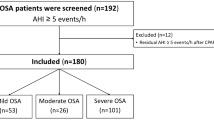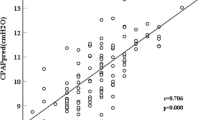Abstract
Background
There have been reports that optimal CPAP pressure can be predicted from a previously derived formula, with the Hoffstein formula being the most accurate and accepted in the literature so far. However, the validation of this predictive model has not been applied in different clinical settings. Our aim was to compare both the Hoffstein prediction formula and a newly derived formula to the CPAP pressure setting assessed during a formal CPAP titration study.
Methods
We prospectively studied 1,111 patients (871 males/240 females) with obstructive sleep apnea hypopnea syndrome (OSAHS) undergoing a CPAP titration procedure. In this large population sample, we tested the Hoffstein formula, utilizing body mass index (BMI), neck circumference and apnea/hypopnea index (AHI), and we compared it with our new formula that included not only AHI and BMI but also smoking history and gender adjustment.
Results
We found that using the Hoffstein prediction formula, successful prediction (predicted CPAP pressure within ±2 cm H2O compared to the finally assessed optimum CPAP pressure during titration) was accomplished in 873 patients (79%), with significant correlation between CPAP predicted pressure (CPAPpred1) and the optimum CPAP pressure (CPAPopt) [r = 0.364, p < 0.001]. With the new formula, including smoking history and gender adjustment, successful prediction was accomplished in 1,057 patients (95%), with significant correlation between CPAP predicted pressure (CPAPpred2) and the CPAPopt (r = 0.392, p < 0.001). However, there was a highly significant correlation between the two formulas (r = 0.918, p < 0.001).
Conclusions
We conclude that the level of CPAP necessary to abolish sleep apnea can be successfully predicted from both equations, using common clinical measurements and prediction formulas that may be useful in calculating the starting pressure for initiating CPAP titration. It may also be possible to shorten CPAP titration and perhaps in selected cases to combine it with the initial diagnostic study.


Similar content being viewed by others
Abbreviations
- AHI:
-
Apnea/hypopnea index
- BMI:
-
Body mass index
- CPAP:
-
Continuous positive airway pressure
- CPAPopt:
-
Optimal CPAP
- CPAPpred:
-
Predicted CPAP
- ECG:
-
Electrocardiogram
- EEG:
-
Electroencephalogram
- EKG:
-
Electrocardiogram
- EMG:
-
Electromyogram
- EOG:
-
Electro-oculogram
- NC:
-
Neck circumference
- OECD:
-
Organization for Economic Co-operation and Development
- OSAHS:
-
Obstructive sleep apnea/hypopnea syndrome
- PSG:
-
Polysomnography
- SaO2 :
-
Oxyhemoglobin saturation
- WC:
-
Waist circumference
References
Young T, Palta M, Dempsey J, Skatrud J, Steven Webe St, Badr S (1993) The occurrence of sleep-disordered breathing among middle-aged adults. N Engl J Med 328:1230–1235
Ronald J, Delaive K, Roos L, Manfreda J, Bahammam A, Kryger M (1999) Health care utilization in the 10 years prior to diagnosis in obstructive sleep apnea syndrome patients. Sleep 22:225–229
Ballester E, Badia JR, Hernández L, Carrasco E, de Pablo J, Fornas C, Rodriguez-Roisin R, Montserrat JM (1999) Evidence of the effectiveness of continuous positive airway pressure in the treatment of sleep apnea/hypopnea syndrome. Am J Respir Crit Care Med 159:495–501
Loube DI, Gay PC, Strohl KP, Pack AI, White DP, Collop NA (1999) Indications for positive airway pressure treatment of adult obstructive sleep apnea patients: a consensus statement. Chest 115:863–866
McArdle N, Grove A, Devereux G, Mackay-Brown L, Mackay T, Douglas NJ (2000) Split-night versus full-night studies for sleep apnoea/hypopnoea syndrome. Eur Respir J 15:670–675
Ayas NT, Patel SR, Malhotra A, Schulzer M, Malhotra M, Jung D, Fleetham J, White DP (2004) Auto-titrating versus standard continuous positive airway pressure for the treatment of obstructive sleep apnea: results of a meta-analysis. Sleep 27:249–253
Whittle A, Finch S, Mortimore I, MacKay TW, Douglas NJ NJ (1997) Use of home sleep studies for diagnosis of the sleep apnoea/hypopnoea syndrome. Thorax 52:1068–1073
Series F (2000) Accuracy of an unattended home CPAP titration in the treatment of obstructive sleep apnea. Am J Respir Crit Care Med 162:94
Stradling JR, Hardinge M, Paxton J, Smith DM (2004) Relative accuracy of algorithm-based prescription of nasal CPAP in OSA. Respir Med 98:152–154
Miljeteig H, Hoffstein V (1993) Determinants of continuous positive airway pressure level for treatment of obstructive sleep apnea. Am Rev Respir Dis 147:1526–1530
Lin IF, Chuang ML, Liao YF, Chen NH, Li HY (2003) Predicting effective continuous positive airway pressure in Taiwanese patients with obstructive sleep apnea syndrome. J Formos Med Assoc 102:215–221
Loredo JS, Berry C, Nelesen RA, Dimsdale JE (2007) Prediction of continuous positive airway pressure in obstructive sleep apnea. Sleep Breath 11:45–51
Hoffstein V, Mareika S (1994) Predicting nasal continuous positive airway pressure. Am J Respir Crit Care Med 150:486–488
Oliver Z, Hoffstein V (2000) Predicting effective continuous positive pressure. Chest 117:1526–1530
Series F, Marc I (1997) Efficacy of automatic continuous positive pressure therapy that uses an estimated required pressure in the treatment of the obstructive sleep apnea syndrome. Ann Intern Med 127:588–595
Masa JF, Jiménez A, Durán J, Capote F, Monasterio C, Mayos M, Teran J, Hernandez L, Barbe F, Maimo A, Rubio M, Montserrat JM (2004) Alternative methods of titrating continuous positive airway pressure: a large multicenter study. Am J Respir Crit Care Med 170:1218–1224
El Solh AA, Aldik Z, Alnabhan M, Grant B (2007) Predicting effective continuous positive airway pressure in sleep apnea using an artificial neural network. Sleep Med 8:471–477
Rowley JA, Tarbichi AGS, Badr MS (2005) The use of a predicted CPAP equation improves CPAP titration success. Sleep Breath 9:26–32
Gokcebey N, Iqbal S, Yang K, Zebrak A, Hirshkowitz M (1996) Accuracy of CPAP predicted from anthropometric and polysomnographic indices. Sleep 19:600–601
Villaneuva AT, Buchanan PR, Yee BJ, Grunstein RR (2005) Ethnicity and obstructive sleep apnoea. Sleep Med Rev 9:419–436
American Academy of Sleep Medicine (1999) Sleep-related breathing disorders in adults: recommendations for syndrome definition and measurement techniques in clinical research; the report of the American Academy of Sleep Medicine task force. Sleep 22:667–689
World Health Organization (1989) Measuring Obesity: Classification and Distribution of Anthropometric Data. World Health Organization, Copenhagen
Ben-Noun L, Sohar E, Laor A (2001) Neck circumference as a simple screening measure for identifying overweight and obese patients. Obes Res 9:470–477
Rechtschaffen A, Kales AA (1968) A manual of standardized terminology, techniques and scoring system for sleep stages of human subjects. National Institute of Health, Washington
No authors listed. EEG arousals: scoring rules and examples: a preliminary report from the Sleep Disorders Atlas Task Force of the American Sleep Disorders Association (1992). Sleep 15:174-184
Fitzpatrick MF, Alloway CE, Wakeford TM, MacLean AW, Munt PW, Day AG (2003) Can patients with obstructive sleep apnea titrate their own continuous positive airway pressure? Am J Respir Crit Care Med 167:716–722
Hertegonne KB, Volna J, Portier S, De Pauw R, Van Maele G (2008) Titration procedures for nasal CPAP: automatic CPAP or prediction formula? Sleep Med 9:732–738
Kashyap R, Hock LM, Bowman TJ (2001) Higher prevalence of smoking in patients diagnosed as having obstructive sleep apnea. Sleep Breath 5:167–172
Hoflstein V (2002) Relationship between smoking and sleep apnea in clinic population. Sleep 25:519–524
Vardavas CI, Kafatos AG (2007) Smoking policy and prevalence in Greece: an overview. Eur J Public Health 17:211–213
Weitzenblum E, Chaouat A, Kessler R, Canuet M (2008) Overlap syndrome: obstructive sleep apnea in patients with chronic obstructive pulmonary disease. Proc Am Thorac Soc 5:237–241
Fleetham J (2003) Is chronic obstructive pulmonary disease related to sleep apnea–hypopnea syndrome? Am J Respir Crit Care Med 167:3–4
Ware JC, McBrayer RH, Scott JA (2000) Influence of sex and age on duration and frequency of sleep apnea events. Sleep 23:165–170
Dancey DR, Hanly PJ, Soong C, Lee B, Shepard J, Hoffstein V (2003) Gender differences in sleep apnea: the role of neck circumference. Chest 123:1544–1550
Rowley JA, Aboussouan LS, Badr MS (2000) The use of clinical prediction formulas in the evaluation of obstructive sleep apnea. Sleep 23:929–938
Vagiakis E, Kapsimalis F, Lagogianni I, Perraki H, Minaritzoglou A (2006) Gender differences on polysomnographic findings in Greek subjects with obstructive sleep apnea syndrome. Sleep Med 7:424–430
Nahmias J, Ramos R, Karetzky M (1995) Nasal CPAP in patients with obstructive sleep apnea: validation of a predictive equation. Sleep Research 24:306
Stradling JR, Hardinge M, Smith DM (2004) A novel, simplified approach to starting nasal CPAP therapy in OSA. Respir Med 98:155–158
West SD, Jones DR, Stadling JR (2006) Comparison of three ways to determine and deliver pressure during nasal CPAP therapy for obstructive sleep apnoea. Thorax 61:226–231
Sforza E, Petiau C, Weiss T, Thibault A, Petiau C, Krieger J (1999) Pharyngeal critical pressure in patients with obstructive sleep apnea syndrome. Clinical implications. Am J Respir Crit Care Med 159:149–157
Akashiba T, Kosaka N, Yamamoto H, Ito D, Saito O, Horie T (2001) Optimal continuous positive airway pressure in patients with obstructive sleep apnoea: role of craniofacial structure. Respir Med 95:393–397
Juhász J, Schillen J, Urbigkeit A, Ploch T, Penzel T, Peter JH (1996) Unattended continuous positive airway pressure titration. Clinical relevance and cardiorespiratory hazards of the method. Am J Respir Crit Care Med 154:359–365
Ruehland WR, Rochford PD, O'Donoghue FJ, Pierce RJ, Singh P, Thornton AT (2009) The new AASM criteria for scoring hypopneas: impact on the apnea hypopnea index. Sleep 32:150–157
Acknowledgments
All authors have contributed to conception and design of the study analysis and interpretation of data, writing the article or revising it critically for important intellectual content and final approval of the version to be published. Dr Tzanakis performed the statistical analysis and interpreted the results. Dr. Schiza and Dr Bouloukaki had full access to all of the data in the study, and take responsibility for the integrity of the data and the accuracy of the data analysis.
Author information
Authors and Affiliations
Corresponding author
Additional information
Sophia E. Schiza and Izolde Bouloukaki contributed equally to this paper.
Rights and permissions
About this article
Cite this article
Schiza, S.E., Bouloukaki, I., Mermigkis, C. et al. Utility of formulas predicting the optimal nasal continuous positive airway pressure in a Greek population. Sleep Breath 15, 417–423 (2011). https://doi.org/10.1007/s11325-010-0352-5
Received:
Revised:
Accepted:
Published:
Issue Date:
DOI: https://doi.org/10.1007/s11325-010-0352-5




